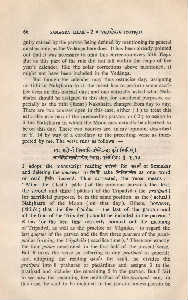Page 714 - Lokmanya Tilak Samagra (khand 2)
P. 714
"
66 SAMAGRA Tn.AK - 2 • VEDANGA JYOTI~HA
.
guity caused by the parvan being defined by mentioning its general
amshas only, as the Vedanga here does. It has been already pointed
out that it was necessary to omit this correction every fifth Yuga.
But as this part of the rule did not fall within the scope of five
year's calender, like the solar corrections above mentioned, it
might not have been included in the Vedanga.
But though the calender may thus ostracise day, assigning
no tithi or Nak~Jbatra to it, the priest has to perform some sacri-
fice even on this outcast day; and one naturally asked what Nak-
IJhatra should be assigned to this day, for sacrificial purposes, es-
pecially as the tithi {lunar) Nakl}batra changed from day to day.
There are two cour es open in this case, either ( 1 ) to treat this
extra day as a part of the prececeding parvan or ( 2 ) to assign to
it the Nakl}hatra in which the Moon may actually be ob erved to
be on this day. These two cour es are in my opinion, described
in Y. 14 by way of a corollary to the preceding verse as inter-
preted by me. The verse runs as follows :-
~: ~~ fSt4'#liR:;t~~s~: ~ ~I
~)~~ ~: q~~~dt: II Y.14
I adopt the manuscript reading ~~ for ~ of Somakar
and deleting the anuswar in ~ take ~~ as one word
or read ~: instead. Thus corrected, the verse means :-
' Mter the ( last ) pa.da ( of the previous parvan ), the first,
the second and third ( padas ) of the Tripadya ( the pratipad)
for sacrificial purposes, be in the same position as the ( actual )
Nak~hatra of the Moon ( on that day). Others, however,
( think ) that the five ( padas - the last of the parvan and
all the four of the Tripadya ) should be included in the parvan. '
B has for the first time correctly pointed out the meaning
of Tripadya, as well as the practice of Yagnik:s ' to regard the
last quarter of the parvan and the first three quarters of the prati-
pad a forming the Yagaklila ( sacrifice time ). ' The e are exactly
the four pddas mentioned in the first half of the present verse.
But B takes the verse as referring to any pratipad in general;
and adopting the reading q-~: for lf!CUii, he divides the
pratipad into 8 praharas or padardhas and assign 3 to the
pratipad and includes the remaining 5 in the parvan. But I fai l
to ee how the remaining five padardhas of the pratipad can, in
this ca e, be said to be included in the parvan unless parvan be

